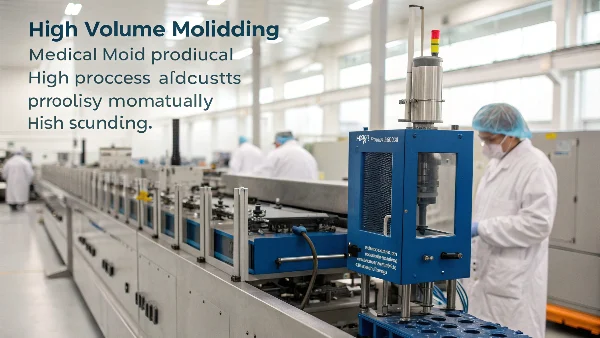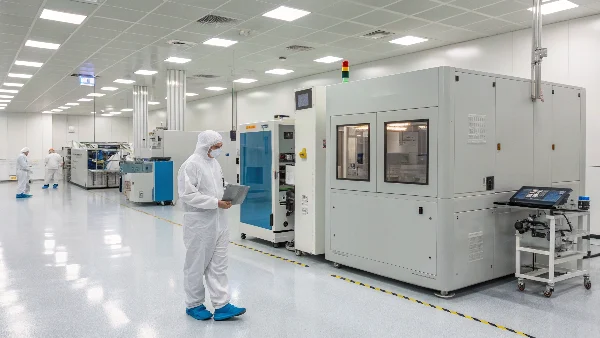Medical device projects stalled by molding complexities? Strict regulations, material choices, and precision demands can feel overwhelming, risking project failure and patient safety. It’s a tough nut to crack!
Successfully molding medical devices involves navigating stringent regulatory compliance (like FDA, CE, ISO 13485), selecting biocompatible materials, ensuring high precision in volume, and often utilizing cleanroom environments.
You know, Alex, moving from some of the general industrial or consumer electronics projects to the medical device world, or even just understanding its unique demands, is a big leap. The stakes are incredibly high – we’re talking about patient well-being here. It’s not just about making a part that fits; it’s about making a part that is safe, reliable, and meets a whole host of stringent requirements. At CAVITYMOLD, while our core is precision across industries, we deeply respect the specific challenges medical molding presents. So, let’s dive into some of those hurdles, because understanding them is the first step to overcoming them, right? I think this area is super interesting.
How Do We Navigate the Labyrinth of Regulatory Compliance and Certifications in Medical Molding?
Drowning in paperwork for FDA, CE, or ISO 13485? Compliance delays can kill your medical device launch and drain resources fast. It’s enough to make your head spin!
Navigating medical regulations means meticulous documentation, rigorous testing, and validation, often partnering with experienced molders who understand these specific standards like ISO 13485.
Dive deeper Paragraph:
So, Alex, the first thing that hits you like a ton of bricks when you talk about medical devices is the regulatory landscape. It’s not like making a toy, where if it breaks, it’s an annoyance. Here, failure can have serious consequences. You’ve got bodies like the US FDA (Food and Drug Administration), the CE marking requirements for Europe, and overarching quality management system standards like ISO 13485, which is specifically for medical device quality. It’s a whole alphabet soup!
The biggest challenge here, as your insight points out, is the sheer volume of documentation, testing, and validation required. I mean, we’re talking detailed design history files (DHFs), device master records (DMRs), risk management files (ISO 14971, another one!), and validation for everything – the mold, the process, the material. This all takes time, serious time, and can massively delay getting a product to market if you’re not prepared. It’s not uncommon for this to add months, or even years, to a project timeline.
But here’s the opportunity: partnering with a molding service provider who gets this, who has experience with these standards, can be a game-changer. Someone who knows the lingo, understands the documentation needs, and has processes already aligned with, say, ISO 13485 principles, can really smooth things out. We at CAVITYMOLD, for instance, while not directly certifying devices, ensure our processes are robust enough to support your compliance efforts. We can provide material certifications, dimensional reports, and process validation data that become crucial parts of your submission package. It’s about being a reliable link in that regulatory chain, ensuring our part – the molded component – doesn’t become a roadblock to your approval. It’s definitely a specialized area, no doubt about it.
Why is Choosing the Right Biocompatible Material So Darn Critical for Medical Devices?
Wrong material for your medical device? This can lead to adverse patient reactions, device failure, and regulatory rejection – a total nightmare, and a costly one at that!
Selecting biocompatible materials like specific medical-grade polypropylenes, polycarbonates, PEEK, or silicones is crucial to prevent harm, ensuring the device is safe, durable, and meets sterilization needs.
!
Dive deeper Paragraph:
Next up, and just as critical, Alex, is material selection and biocompatibility. This is a huge one. You can’t just pick any old plastic off the shelf. The materials used in medical devices, especially those that come into contact with the body – even briefly – must be biocompatible. This means they can’t cause any adverse reactions like toxicity, irritation, or allergic responses. Think about it – an implant, a catheter, even a drug delivery component – the material is fundamental to its safety.
The challenge, as your notes rightly highlight, is that the chosen material has to tick a whole bunch of boxes.
- Biocompatibility: Often tested to ISO 10993 standards.
- Durability: It needs to withstand the stresses of its intended use and lifespan.
- Sterilization Compatibility: Many medical devices need to be sterilized – by steam (autoclave), Ethylene Oxide (EtO), gamma radiation, or E-beam. The material must maintain its properties and integrity after one or multiple sterilization cycles. Some plastics yellow or become brittle with radiation, for example.
- Chemical Resistance: It might need to resist cleaning agents or drugs.
- Cost-Effectiveness: While safety is paramount, cost is always a factor.
Common medical-grade materials include certain grades of polypropylene (PP), polycarbonate (PC), polyethylene (PE), PEEK (polyether ether ketone) for high-performance applications, and medical-grade silicones (LSR – Liquid Silicone Rubber). The specific choice is super dependent on the application.
The opportunity here, again, lies in expertise. A molding partner with deep knowledge of these materials and their suppliers can guide you to the optimal choice. They’ll understand the trade-offs and help ensure the material selected isn’t just moldable, but also safe, functional, and compliant. We’ve had projects where a client initially specified a material that wouldn’t withstand their chosen sterilization method. Catching that early saved a lot of headaches and redesign costs. It’s about that collaborative approach.Can We Really Achieve Pinpoint Precision and Unwavering Consistency in High-Volume Medical Molding?
Inconsistent medical parts leading to functional failures or safety risks? High-volume precision is tough, and even tiny errors can have huge consequences for patients.
Achieving high precision and consistency in volume for medical devices relies on advanced molding equipment, robust process controls (SPC), high-quality molds, and often automation to minimize defects.

Dive deeper Paragraph:
Now let’s talk precision, Alex. Medical devices often involve incredibly complex designs and demand extremely tight tolerances. Think about microfluidic components, parts for surgical instruments, or drug delivery systems where dosages depend on the precision of tiny channels or chambers. And it’s not just about getting one perfect part; it’s about achieving that same pinpoint precision consistently, part after part, often in high volumes.
The challenge, as you noted, is that maintaining this high level of accuracy, especially when you scale up production, is far from easy. Any inaccuracies in the mold, variations in the molding process (temperature, pressure, cooling time), or inconsistencies in the material can lead to defects. And in the medical field, a "defect" isn’t just a cosmetic flaw; it can impact the device’s function, its ability to assemble correctly, and ultimately, patient safety. Imagine a luer lock fitting that leaks because of a dimensional issue – that’s a serious problem.
The opportunity here lies in leveraging advanced technology and rigorous process control. This is where a company like CAVITYMOLD truly shines, because precision is our core. We’re talking about:
- State-of-the-art injection molding machines: With precise control over all parameters.
- High-precision mold making: Using CNC machining, EDM (Electrical Discharge Machining), and expert mold makers. The mold is the heart of the process.
- Scientific Molding principles & Process Validation (IQ/OQ/PQ): Establishing a robust and repeatable process window.
- Statistical Process Control (SPC): Continuously monitoring critical dimensions and process parameters to detect and correct any drift before it results in out-of-spec parts.
- Automation: For part handling, inspection, and packaging to reduce variability and contamination.
- Advanced Metrology: Using CMMs, vision systems, and custom gauges to verify dimensions.
It’s about building quality in, not just inspecting it out. For medical parts, we might implement even tighter control limits and more frequent inspections than for other industries. It’s an investment, for sure, but it’s absolutely necessary.Are Cleanrooms an Absolute Must-Have for Medical Device Injection Molding, and What’s Involved?
Contamination ruining your sterile medical components? For many devices, especially implantables or those contacting patients, a standard environment just won’t cut it. This is serious stuff.
Cleanroom molding (e.g., ISO Class 7 or 8) is essential for many medical devices to prevent particulate and microbial contamination, especially for sterile or direct patient-contact parts.

Dive deeper Paragraph:
Finally, Alex, let’s touch on something often non-negotiable for medical molding: cleanroom environments. For many medical devices, especially those that are implanted, come into contact with bodily fluids, or need to be supplied sterile, manufacturing in a standard factory environment just isn’t an option. Particulate matter, dust, microorganisms – these can all be contaminants that compromise the safety and efficacy of the device.
The challenge here is that establishing and maintaining a certified cleanroom is a significant undertaking. We’re talking about specialized air handling systems (HEPA filters), gowning procedures for personnel, controlled material flow, specific cleaning protocols, and regular environmental monitoring (air particle counts, surface testing). Cleanrooms are classified according to standards like ISO 14644-1 (e.g., ISO Class 7 or ISO Class 8 are common for medical molding). Keeping that environment consistently within spec requires ongoing investment and strict discipline. It’s not something you just set up and forget.
The opportunity, however, is clear. For a molder, having cleanroom capabilities opens the door to a wider range of medical device projects. For you, as a product designer or project manager, partnering with a molder who offers cleanroom production means you can be confident that your components are being manufactured in an environment that minimizes the risk of contamination. This is particularly critical for components that will later be sterilized and packaged. Even if the molding itself isn’t done in a super-high-grade cleanroom, sometimes assembly or packaging of the molded parts might be. It all depends on the risk assessment for your specific device. At CAVITYMOLD, while we assess cleanroom needs on a project-by-project basis with partners, we understand the critical importance and the systems required to support such manufacturing if a project demands it. It’s another layer of control for these ultra-critical applications.
Conclusion
Successfully molding medical devices demands navigating compliance, choosing biocompatible materials, ensuring precision, and often using cleanrooms – a truly specialized, high-stakes endeavor for patient safety.
